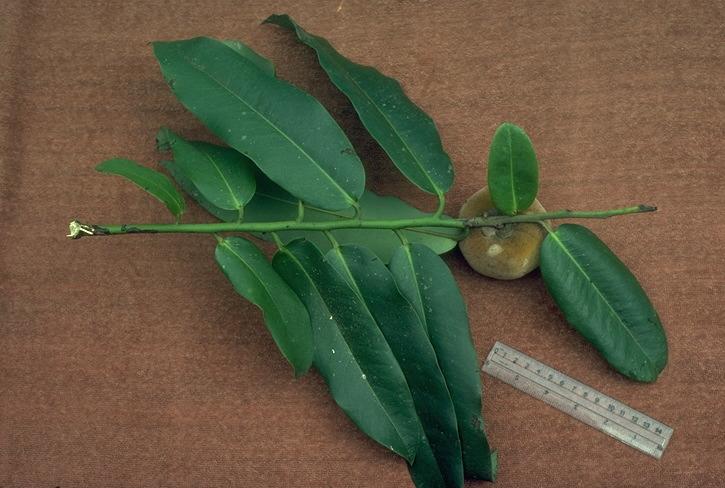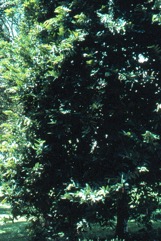Mabolo, Velvet apple

A tropical and subtropical plant. It suits the hot humid tropical lowlands. Mature trees can withstand light frost for short times. Young trees do not tolerate low temperatures. It is better to have trees in sheltered places protected from cold winds. Slightly acid, moist and free draining soils are best. It can grow in sun or light shade. It cannot tolerate salt. Plants grow naturally in the Philippines. It is common and widely distributed in the forests of the Philippines. It has become established wild in the bush in the Gazelle Peninsula of Papua New Guinea. It grows from sea level to 200m altitude in Taiwan. It suits hardiness zones 9-12.
Also known as:
Bilayati gab, Bisbul, Buah choklat, Buah lemak, Buah mantega, Buah mentaga, Buah sakhlat, Butterfruit, Camagong, Chalta, Hong nhung, Kadiba, Kadiba-thi, Kamagong, Marit, Persimo, Persimonio, Pohon bisbul, Tabang, Talang, Tayok-te, Yi se shi
Synonyms
- Cavanillea mabolo Poir
- Cavanillea philippensis Desr.
- Diospyros blancoi A. DC.
- Diospyros durionoides Bakh.
- Diospyros mabolo (Poir.) Roxb. ex Lindl. [Illegitimate]
- Diospyros mabola Roxb. ex J. V. Thomps. [Illegitimate]
- Diospyros malacapai A. DC.
- Diospyros merrillii Elmer
- Diospyros philippensis (Desr.) Guerke [Illegitimate]
- Diospyros utilis Hemsl.
- Embryopteris discolor G. Don
- Mabola edulis Raf.
Edible Portion
- Fruit
Where does Mabolo grow?
Found in: Africa, Asia, Australia, Bangladesh, Bermuda, Brazil, Caribbean, Central America, China, Cook Islands, Cuba, Guiana, Guyana, Hawaii, Honduras, India, Indochina, Indonesia, Jamaica, Malaysia, Mexico, Myanmar, Pacific, Papua New Guinea, Philippines, PNG, Puerto Rico, SE Asia, Singapore, South America, St Lucia, Taiwan, Thailand, Trinidad, United States, Vietnam, West Africa, West Indies
Notes: There are about 485 species of Diospyros mostly in the tropics.
Status: The fruit are popular and widely used and sold. It is a cultivated food plant. At present only of minor importance in some coastal areas of Papua New Guinea. It is better suited to Papua New Guinea than the Japanese persimmon (Diospyros kaki ).
Growing Mabolo, Velvet apple
Cultivation: They are cultivated for the fruit popularly known as mabalo. Trees are mostly grown from seed. Plants are normally grown from seed. A spacing of 5 m is needed. Trees should be left unattended prior to flowering. It is possible to do grafting and air-layering.
Edible Uses: The fruit is eaten fresh or made into jellies or juice. The fleshy portion of the fruit is eaten raw when ripe. The hairs and skin are removed.
Production: A slow growing tree. It may take three years for seedling trees to be large enough to transplant. Fruiting is not normally seasonal. Fruit ripening takes 2-4 months from flowering.
Nutrition Info
per 100g edible portion| Edible Part | Energy (kcal) | Protein (g) | Iron (mg) | Vitamin A (ug) | Vitamin c (mg) | Zinc (mg) | % Water |
|---|---|---|---|---|---|---|---|
| Fruit | 50 | 0.8 | - | - | - | - | 77 |
Mabolo, Velvet apple Photos


References
Alegado, A. M. & De Guzman, R. B., 2014, Indigenous food crops of the Aetas tribe in the Philippines and their traditional methods of food preparation. in Promotion of Underutilized Indigenous Food Resources for Food Security and Nutrition in Asia and Pacific. FAO. Bangkok p 160 (As Diospyros philippensis)
Ambasta, S.P. (Ed.), 2000, The Useful Plants of India. CSIR India. p 176 (As Diospyros discolor)
Arora, R. K., 2014, Diversity in Underutilized Plant Species - An Asia-Pacific Perspective. Bioversity International. p 66 (Also as Diospyros blancoi)
Aubrev. et al., eds. 1961-. Flore du Gabon. (As Diospyros philippensis)
BARC, 2016, State of Biodiversity for Food and Agriculture in Bangladesh. Bangladesh Agricultural Research Council.
Barwick, M., 2004, Tropical and Subtropical Trees. A Worldwide Encyclopedic Guide. Thames and Hudson p 149 (As Diospyros blancoi)
Brown, W.H., 1920, Wild Food Plants of the Philippines. Bureau of Forestry Bulletin No. 21 Manila. p 148 (As Diospyros discolor)
Burkill, H. M., 1985, The useful plants of west tropical Africa, Vol. 1. Kew. (As Diospyros blancoi)
Burkill, I.H., 1966, A Dictionary of the Economic Products of the Malay Peninsula. Ministry of Agriculture and Cooperatives, Kuala Lumpur, Malaysia. Vol 1 (A-H) p 841 (As Diospyros discolor)
Carig, Elizabeth T., 2020, Guidebook on Native Trees within the Quirino Forest Landscape. Plaridel, Bulacan, St. Andrew Publishing House. p 71 (As Diospyros discolor)
Chin, H.F., & Yong, H.S., 1996, Malaysian Fruits in Colour. Tropical press, Kuala Lumpur p 65 (As Diospyros discolor)
Coronel, R.E., 1982, Fruit Collections in the Philippines. IBPGR Newsletter p 6 (As Diospyros blancoi)
Darley, J.J., 1993, Know and Enjoy Tropical Fruit. P & S Publishers. p 27 (As Diospyros discolor)
Dassan. & Fosb. 1980-. A revised handbook to the flora of Ceylon. (As Diospyros philippensis)
H. G. A. Engler & K. A. E. Prantl, Nat. Pflanzenfam. 4(1):164. 1891 (non D. philippinensis A. DC. 1844) (As Diospyros philippensis)
Facciola, S., 1998, Cornucopia 2: a Source Book of Edible Plants. Kampong Publications, p 92 (As Diospyros discolor)
Flora reipublicae popularis sinicae. (F China) [=D. philippensis (Desr.) Guerke]. (As Diospyros philippensis)
Flora of China. Vol. 15, p 232 and Flora of China. www.eFloras.org (As Diospyros philippensis)
French, B.R., 1986, Food Plants of Papua New Guinea, A Compendium. Asia Pacific Science Foundation p 289 (As Diospyros philippensis)
Hearne, D.A., & Rance, S.J., 1975, Trees for Darwin and Northern Australia. AGPS, Canberra p 53 (As Diospyros discolor)
Howard, R. A., 1971. Baileya 18:26. (As Diospyros philippensis)
Howard, R., 1974-. Flora of the lesser Antilles. (As Diospyros philippensis)
Hedrick, U.P., 1919, (Ed.), Sturtevant's edible plants of the world. p 276 (As Diospyros discolor)
Jardin, C., 1970, List of Foods Used In Africa, FAO Nutrition Information Document Series No 2.p 133 (As Diospyros discolor)
Jayaraman, U., & Singh, V., 1987, A Census of Edible Species of Diospyros L. in India. J. Econ. Tax. Bot. Vol. 10 No. 2 pp 416-419 (As Diospyros discolor) (As Diospyros philippensis)
John, L., & Stevenson, V., 1979, The Complete Book of Fruit. Angus & Robertson p 183 (As Diospyros discolor)
Kiple, K.F. & Ornelas, K.C., (eds), 2000, The Cambridge World History of Food. CUP p 1804 (As Diospyros discolor)
Knapp., S. and Gilbert, M. G., 2002, Proposal to Conserve the Name Diospyros discolor against Cavanillea philippensis (Ebenaceae) Taxon, Vol. 51, No. 3, pp. 579-580 (Also as Diospyros philippensis)
Kuo, W. H. J., (Ed.) Taiwan's Ethnobotanical Database (1900-2000), http://tk.agron.ntu.edu.tw/ethnobot/DB1.htm (As Diospyros philippensis)
Lembaga Biologi Nasional, 1977, Buah-Buahan, Balai Pustaka, Jakarta. p 22 (As Diospyros philippensis)
Llamas, K.A., 2003, Tropical Flowering Plants. Timber Press. p 185 (As Diospyros blancoi)
Macmillan, H.F. (Revised Barlow, H.S., et al) 1991, Tropical Planting and Gardening. Sixth edition. Malayan Nature Society. Kuala Lumpur. p 298 (As Diospyros blancoi)
Martin, F. W., et al, 1987, Perennial Edible Fruits of the Tropics. USDA Handbook 642 p 25
Merrill 1922-1926. An enumeration of Philippine flowering plants. (As Diospyros philippensis)
Miguel, E., et al, 1989, A checklist of the cultivated plants of Cuba. Kulturpflanze 37. 1989, 211-357 (As Diospyros blancoi)
Milow, P., et al, 2013, Malaysian species of plants with edible fruits or seeds and their evaluation. International Journal of Fruit Science. 14:1, 1-27 (As Diospyros blancoi)
Monsalud, M.R., Tongacan, A.L., Lopez, F.R., & Lagrimas, M.Q., 1966, Edible Wild Plants in Philippine Forests. Philippine Journal of Science. p 461 (As Diospyros philippensis)
Morton, Julia F., 1987, Fruits of Warm Climates. Creative Resources Systems, Inc. . p. 418
Omawale, 1973, Guyana's edible plants. Guyana University, Georgetown p 33 (As Diospyros discolor)
Pasha, M. K. & Uddin, S. B., 2019, Minor Edible Fruits of Bangladesh. Bangladesh J. Plant Taxon. 26(2): 299–313 (As Diospyros blancoi)
Peekel, P.G., 1984, (Translation E.E.Henty), Flora of the Bismarck Archipelago for Naturalists, Division of Botany, Lae, PNG. p 433, 434 (As Diospyros discolor)
Pham-Hoang Ho, 1999, An Illustrated Flora of Vietnam. Nha Xuat Ban Tre. p 642 (As Diospyros philippensis)
Priyadi, H., et al, Five hundred plant species in Gunung Halimun Salak National Park West Java. A checklist including Sundanese names, distribution and use. CIFOR, FFPRI, SLU p 24
Prodr. 8:237. 1844 (As Diospyros blancoi)
PROSEA (Plant Resources of South East Asia) handbook, Volume 2, 1991, Edible fruits and nuts. (As Diospyros blancoi)
Segura, S., et al, 2018, The edible fruit species in Mexico. Genet Resour Crop Evol (2018) 65:1767–1793 (As Diospyros blancoi)
Staples, G.W. and Herbst, D.R., 2005, A tropical Garden Flora. Bishop Museum Press, Honolulu, Hawaii. p 271 (Drawing) (As Diospyros blancoi)
Sukarya, D. G., (Ed.) 2013, 3,500 Plant Species of the Botanic Gardens of Indonesia. LIPI p 235
Tankard, G., 1990, Tropical fruit. An Australian Guide to Growing and using exotic fruit. Viking p 66 (As Diospyros discolor) (Also as Diospyros philippensis)
Tate, D., 1999, Tropical Fruit. Archipelago Press. Singapore. p 56 (As Diospyros blancoi)
Terrell et al. 1986. Agric. Handb. no. 505.
USDA, ARS, National Genetic Resources Program. Germplasm Resources Information Network - (GRIN). [Online Database] National Germplasm Resources Laboratory, Beltsville, Maryland. Available: www.ars-grin.gov/cgi-bin/npgs/html/econ.pl (10 April 2000) (As Diospyros blancoi)
van Wyk, B., 2005, Food Plants of the World. An illustrated guide. Timber press. p 179 (As Diospyros blancoi)
Verheij, E. W. M., and R. E. Coronel, eds. 1991. Edible fruits and nuts. In: E. W. M. Verheij & R. E. Coronel (eds.), Plant Resources of South-East Asia (PROSEA). 2:151. (As Diospyros philippensis)
Whitmore, T. C., I.G.M. Tantra & U. Sutisna (eds.). 1989. Tree flora of Indonesia, Check list for Kalimantan (As Diospyros philippensis)
Whitmore, T. C., I.G.M. Tantra & U. Sutisna (eds.). 1989. Tree flora of Indonesia, Check list for Sulawesi. (As Diospyros philippensis)
Woodson & Schery, eds. 1943-1980. Flora of Panama. (As Diospyros philippensis)
World Checklist of Useful Plant Species 2020. Royal Botanic Gardens, Kew
www.tradewindsfruit.com
Zawiah, N. & Othaman, H., 2012, 99 Spesies Buah di FRIM. Institut Penyelidikan Perhutanan Malaysia. p 96 (As Diospyros blancoi)